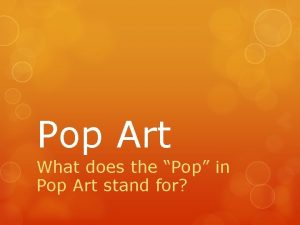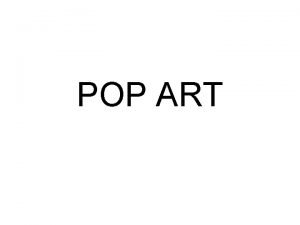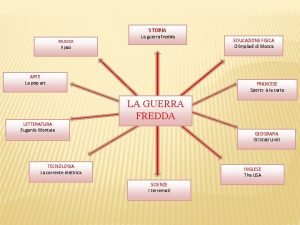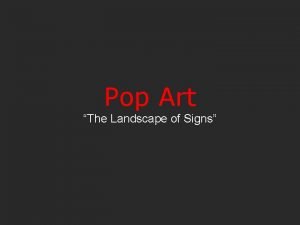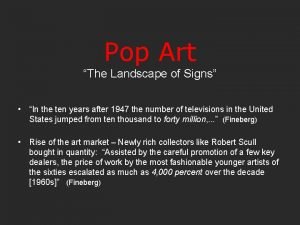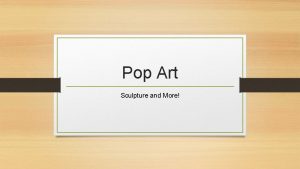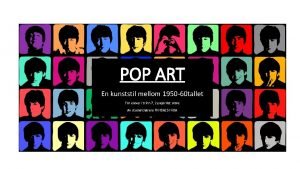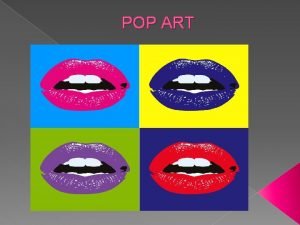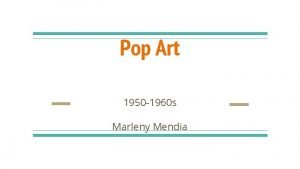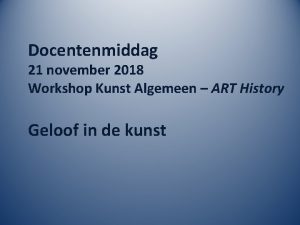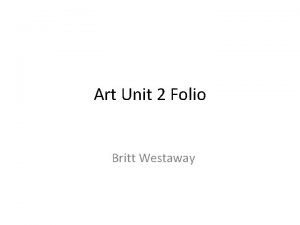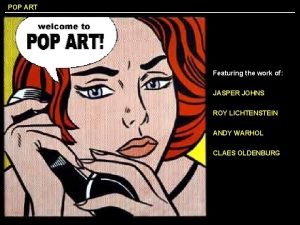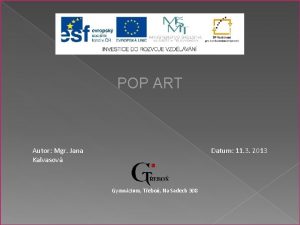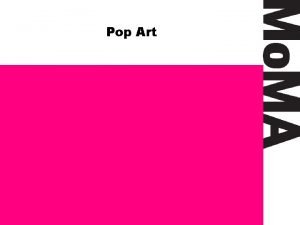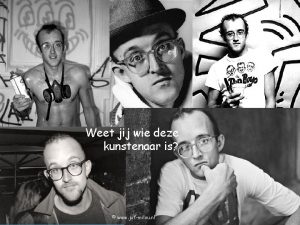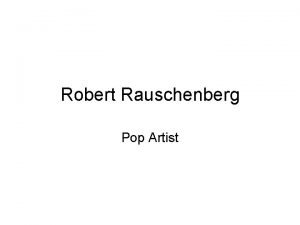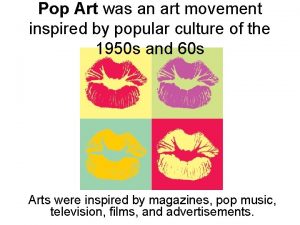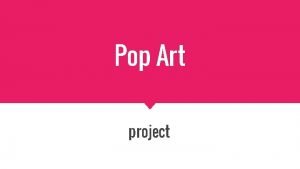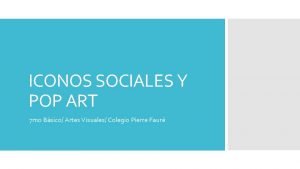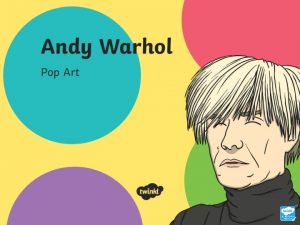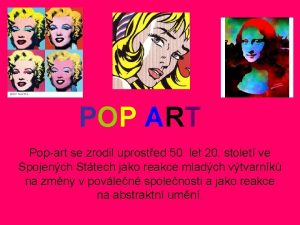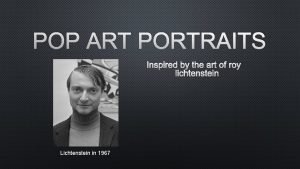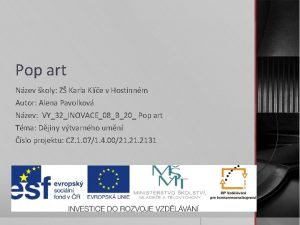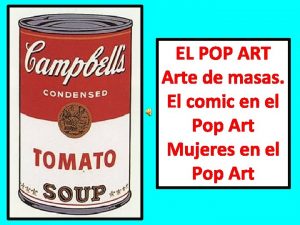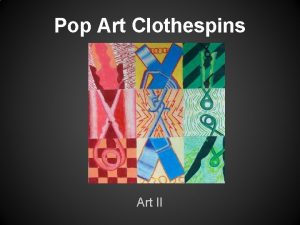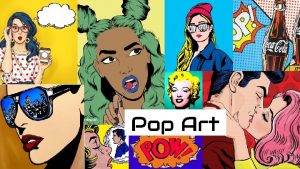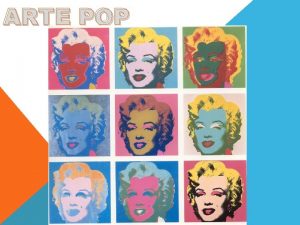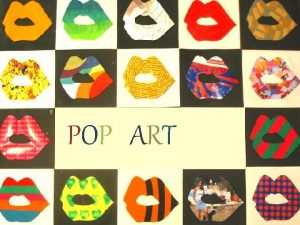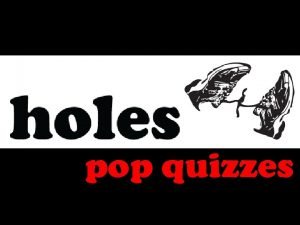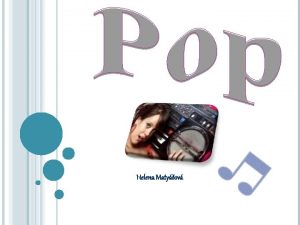POP ART The title of this art movement



















































- Slides: 51

POP ART

• The title of this art movement comes from the word popular – as in popular music, or pop music. Pop Art took its inspiration from popular culture – the culture of the populace, of the people.

• It began in the late 1950 s and is especially associated with the 1960 s. Pop art reflected everyday life and common objects. Pop artists blurred the line between fine art and commercial art. •

• Andy Warhol • Campbell’s Soup Can

Is this fine art or just packaging?

Richard Hamilton, a British artist and critic, referred to Pop Art, as, "popular, transient, expendable, lowcost, mass-produced, young, witty, sexy, gimmicky, glamorous, and Big Business" – he stressed Pop Art’s everyday, commonplace values.

• Many people loved this democratization of art. Art didn’t have to be elitist, they felt. Why not make it accessible and understandable to the masses, they argued.

• Others felt that Pop Art cheapened the traditional function of art, which was to uphold and represent culture’s most valuable ideals. • What do you think?

• Pop Artists used common images from everyday culture as their sources including: advertisements, celebrities, comic strips, photographs, and consumer goods

Andy Warhol – Marilyn Monroe

• Roy Lichtenstein

• Lichtenstein – Mmaybe

• Pop Artists used bold, flat colors and hard edge compositions adopted from commercial designs like those found in: billboards, murals, magazines, and newspapers.

• Pop Artists reflected 60’s culture by using new materials in their artworks including: acrylic paints, plastics, photographs, fluorescent colours and metallic colours. • They experimented with new technologies and methods: Mass production, Fabrication , Photography, Printing, and Serials.

Andy Warhol





Warhol started out as a graphic artist creating shoe ads.




• However, by the early 1960 s he was considered the pope of Pop Artists. Part of his artistic practice was using new technologies and new ways of making art including: Photographic Silk. Screening • Repetition • Mass production • Collaboration • Media events

• Warhol’s studio in the 1960 s in New York was known as The Factory – where, with a team of assistants, Warhol was putting out a tremendous body of work.

The Factory was a meeting place and a magnet for artists, actors, writers, poets, musicians and bohemians of every stripe. Warhol regularly invited people he met to drop in there and do screen tests.

• His open door policy ended in 1968 when Warhol was shot by an irate woman whose script had not received the attention she had hoped for from Warhol. • He came close to dying, but recovered from the gunshot.

Warhol appropriated (used without permission) images from magazines, newspapers, and press photos of the most popular people of his time including Elizabeth Taylor and Jackie Kennedy.

• Andy Warhol • Jackie Kennedy

Andy Warhol – silkscreen print of Jackie Kennedy

Andy Warhol – silkscreen print of the actress Elizabeth Taylor

• Andy Warhol • Elvis Presley • Warhol created 20 versions of this image, including a triple Elvis that sold for $37 million dollars.

Brigitte Bardot – French actress

• Andy Warhol • Silkscreen print of the actress Ingrid Bergman

Warhol took common everyday items and gave them importance as “art. ” He raised questions about the nature of art. For example: What makes one work of art better than another?

Brillo Pads • This is a wooden sculpture, one of a series of “grocery store” subjects.



Warhol the film maker • Between 1963 and 1968, Andy Warhol made more than 60 films, plus some 500 short black-and-white "screen test" portraits of Factory visitors. One of his most famous films, Sleep, monitors poet John Giorno sleeping for six hours. The film Eat consists of a man eating a mushroom for 45 minutes.


Robert Rauschenberg

Rauschenberg began to create what he called combines, in the late 1950 s. He would assemble unlikely combinations of objects as three dimensional sculptures.

As the Pop Art movement developed in the 1960 s, he turned from three dimensional “combines” to silkscreened collages, using magazine and newspaper photographs and then painting into and over

These collages allowed him to make visual statements about contemporary issues.

• Robert Rauschenberg

• Robert Rauschenberg • Signs

Roy Lichtenstein

• Drowning Girl

Roy Lichtenstein

In the Car – Roy Lichtenstein

 What does the pop in pop art stand for
What does the pop in pop art stand for Pop art title
Pop art title Pop art characteristics
Pop art characteristics Prefatory and supplementary part of proposal
Prefatory and supplementary part of proposal Title title
Title title Movement and non-movement area
Movement and non-movement area Axial in dance
Axial in dance Workshop pop art
Workshop pop art Jazz e guerra fredda
Jazz e guerra fredda Adobe illustrator pop art
Adobe illustrator pop art Back seat dodge 38
Back seat dodge 38 October 18 1977
October 18 1977 Modern pop art sculpture
Modern pop art sculpture Popkunsten
Popkunsten Expresionismo abstracto caracteristicas
Expresionismo abstracto caracteristicas Pop art 1960
Pop art 1960 1950 pop art
1950 pop art Brain pop art
Brain pop art Workshop pop art
Workshop pop art Pop art reino unido
Pop art reino unido Pop art mind map
Pop art mind map Definisi pop art
Definisi pop art Pop art autor
Pop art autor Muzika ruscha
Muzika ruscha Elimi beş yerinden dağladı sözleri
Elimi beş yerinden dağladı sözleri Xxx pop art
Xxx pop art Juf milou kunst
Juf milou kunst Scientific method brainpop
Scientific method brainpop Bmw pop art
Bmw pop art Art pop genre
Art pop genre Ben day dots art
Ben day dots art Project pop art
Project pop art Iconos sociales y culturales
Iconos sociales y culturales Gymnosperm life cycle
Gymnosperm life cycle Pop art repeated images
Pop art repeated images 50 pop art
50 pop art What was pop art rebelling against
What was pop art rebelling against Roy lichtenstein influences
Roy lichtenstein influences Pop art prezentace
Pop art prezentace Tecnicas del pop art
Tecnicas del pop art Kakov
Kakov Hình ảnh bộ gõ cơ thể búng tay
Hình ảnh bộ gõ cơ thể búng tay Bổ thể
Bổ thể Tỉ lệ cơ thể trẻ em
Tỉ lệ cơ thể trẻ em Gấu đi như thế nào
Gấu đi như thế nào Tư thế worms-breton
Tư thế worms-breton Chúa yêu trần thế alleluia
Chúa yêu trần thế alleluia Các môn thể thao bắt đầu bằng tiếng nhảy
Các môn thể thao bắt đầu bằng tiếng nhảy Thế nào là hệ số cao nhất
Thế nào là hệ số cao nhất Các châu lục và đại dương trên thế giới
Các châu lục và đại dương trên thế giới Công thức tính thế năng
Công thức tính thế năng
